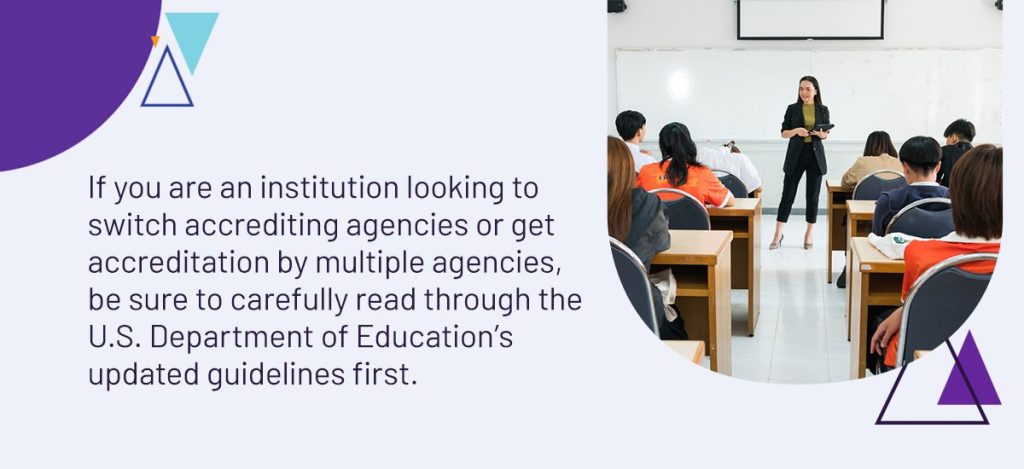




American colleges and universities must navigate numerous regulatory changes to maintain their accreditation status. North Carolina, for example, passed a law in 2023 that prohibits public higher ed institutions from having the same accreditor for consecutive terms, meaning they’ll need to seek out a new accrediting agency every 5 to 10 years. The law is similar to legislation passed in Florida that requires its public institutions to switch every decade. Although some colleges and universities may be forced to make this move, others choose it for themselves.
Whether your institution is facing this change as a result of new legislation or its own goals, switching accreditors necessitates careful planning and strategic execution to ensure a smooth transition. This blog covers general tips for higher education institutions undergoing the transition to a new accrediting body, covering everything from understanding the requirements to engaging with the new accreditor and ensuring continuity and quality.
The requirement for some colleges and universities to switch accreditors stems from legislative and policy changes that are said by advocates to enhance the quality and accountability in higher education. While the policies claim to foster diverse evaluation perspectives, they are controversial and their long-term effects on higher education remain to be seen. The results of the 2024 election will likely shape how widespread this mandate for periodic reevaluation and reaccreditation by different accrediting bodies becomes.
For better or worse, compliance with new requirements is crucial, as accreditation affects everything from federal funding eligibility to the institution’s reputation and student enrollment. Colleges and universities must stay informed about the specific legislative and policy changes impacting their accreditation status and prepare accordingly to meet these new mandates. If you are an institution looking to switch accrediting agencies or get accreditation by multiple agencies, be sure to carefully read through the U.S. Department of Education’s updated guidelines first.
Selecting a new accrediting body is a critical step in the transition process. Higher education institutions must consider several criteria when evaluating potential accreditors. These might include:
Resources for researching accrediting bodies include official websites, peer institutions that have undergone similar transitions, and accreditation reports. Engaging with these resources will help colleges and universities make an informed decision about their new accreditor.

Effective preparation is key to a successful transition. Colleges and universities should begin by establishing a transition team composed of individuals with diverse expertise. This team should include representatives from administration, faculty, finance, and student services. The roles and responsibilities of each team member should be clearly defined to ensure accountability and coordination.
Developing a detailed timeline and project plan for the transition process is also essential. This plan should outline key milestones, deadlines, and deliverables, helping to keep the transition on track. Communication strategies are equally important. Keeping stakeholders — faculty, staff, students, and board members — informed throughout the process fosters transparency and support.
Accreditation requires extensive documentation, including institutional reports, financial statements, and assessment data. Colleges and universities should take inventory of all necessary documents and organize them systematically.
Best practices for organizing and presenting documentation include:
Efficient documentation management not only facilitates the accreditation process but also ensures that the college can respond promptly to any additional information requests from the accreditor.
Establishing a positive relationship with the new accrediting body is imperative. Initial contact should be made early in the process to begin building rapport and understanding the accreditor’s expectations.
Higher ed institutions should familiarize themselves with the new accreditor’s standards and expectations by reviewing their guidelines and past accreditation reports. Scheduling and preparing for site visits or evaluations is another critical step. Colleges and universities should organize mock site visits and prepare comprehensive presentations to demonstrate compliance with the accreditor’s standards.
Maintaining educational quality and institutional integrity during the transition is paramount. Colleges and universities can implement strategies to address potential disruptions or challenges, such as:
Ongoing assessment and improvement supports the accreditation process and contributes to the institution’s overall excellence.

Colleges and universities can benefit from seeking guidance from peer institutions that have successfully navigated similar transitions. Professional organizations and networks offer valuable support, providing resources, best practices, and networking opportunities.
Exploring funding opportunities is also essential to support the transition process. Grants and financial assistance from federal and state agencies, as well as private foundations, may be available to help cover the costs associated with accreditation.
Effective communication with stakeholders is vital throughout the transition process. Regular updates on the progress of the transition should be provided to internal and external stakeholders, including faculty, staff, students, alumni, and the local community.
Addressing concerns and feedback from the college community fosters a sense of involvement and support. Celebrating milestones and successful accreditation boosts morale and reinforces the institution’s commitment to quality and excellence.
Transitioning to a new accrediting body is a complex but manageable process. This period of change can be viewed as an opportunity for growth and improvement, reinforcing the institution’s adaptability and resilience in the face of evolving accreditation requirements.
Ready to embrace this challenge with a strategic, proactive approach and position your institution for continued success and excellence? Learn how Watermark solutions can support you.

























































































































































































































































































































































































Submit this form to schedule a meeting with one of our reps to learn more about our solutions. If you need customer support instead, click here.